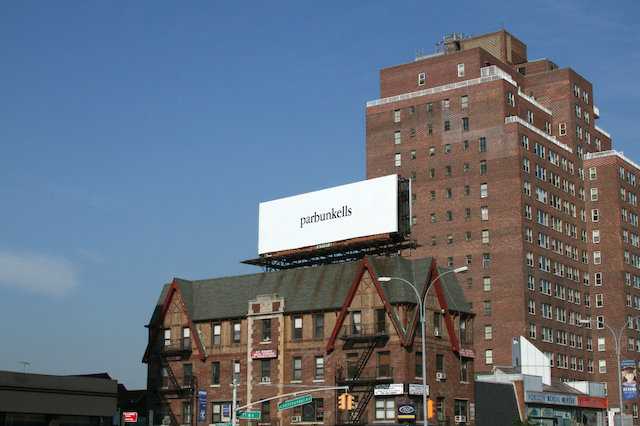Selected by Orit Gat
At the time of writing this piece, there are 2,810 results on Google for the word ‘parbunkells’. When I first looked it up, Google only served up one result: Julia Weist’s website. Parbunkells means ‘coming together through the binding of two ropes’, and the word hadn’t been used much since the seventeenth century until in 2015 Julia Weist printed it on a billboard in Queens, New York as part of public art series 14×48. She called the project Reach, and whenever someone subsequently googled the word they would stumble upon a page with a text by the artist, beginning, ‘This is where I came to be alone. We’re here together now.’ For each page click a light bulb lit up in Weist’s home in Upstate New York.
Reach was not the first project by Weist to employ Google search results. In the work titled After, About, With (2013–15), she skewed the reading of Haim Steinbach’s vinyl wall piece ‘And to think it all started with a mouse (1995/2004), by actively manipulating the search results for it. By partnering with various writers (I was one of them) she ensured that the same reference – that the work was in fact about Disney – was planted in articles in numerous publications from the Paris Review to the Brooklyn Rail. The Disney reading became the most commonly found record of the work’s meaning. At least if you googled it.
Weist’s meddling with Steinbach’s search results brings up nuanced questions about how meaning is constructed: is Steinbach’s idea of the work’s subject more legitimate than a meaning repeatedly dispersed in reputable art magazines? Does weighting a search result transform the work? And how is Google’s algorithm dictating the way we assess information. Weist distills these questions into her work, which also includes collections of books deaccessioned from public libraries; an ongoing attempt to find and photograph multiples of garage-sale knickknacks, without using eBay, and a self-penned romance novel titled Sexy Librarian, with an accompanying self-explanatory shelf- work titled, All The Library-Owned Copies Of Sexy Librarian I Was Able To Borrow (2009).
The obscurity of the word parbunkells is so long gone that it now features on Redbubble – online seller of meme-themed T-shirts, cards, mugs, totes etc. But the transition from a public artwork to the feeling of being alone on Google is both a unique experience and something that couldn’t exist at any other time. Google has become a mediator through which we understand the world. The implications thereof has become, in Weist’s work, a subject that is as poetic as it is necessary.
Born and based in New York, Julia Weist has a BFA from Cooper Union School of Art and a Masters in Library and Information Science from Pratt Institute. She has a solo show at New York’s 83 Pitt Street, through 21 February.
This article was first published in the January & February 2016 issue of ArtReview.
